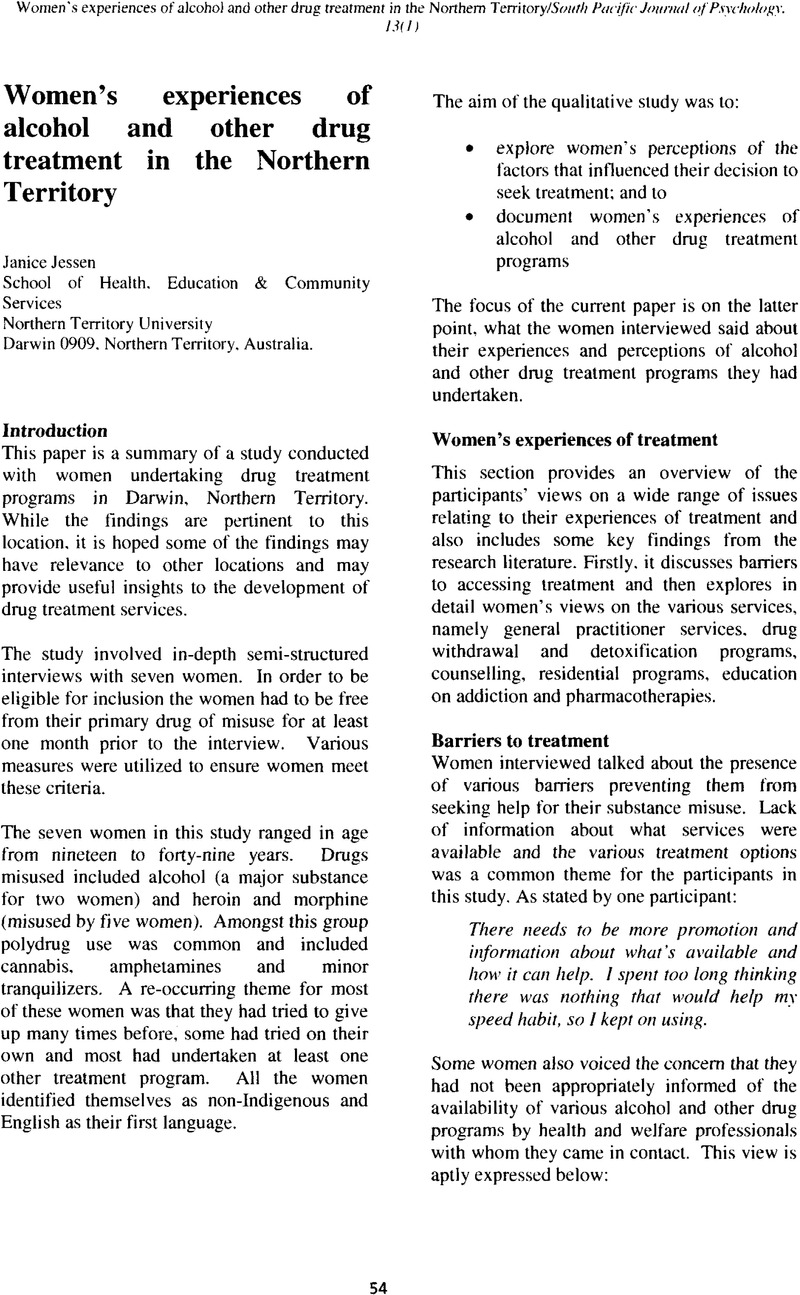No CrossRef data available.
Article contents
Women's experiences of alcohol and other drug treatment in the Northern Territory
Published online by Cambridge University Press: 05 May 2015
Abstract
An abstract is not available for this content so a preview has been provided. Please use the Get access link above for information on how to access this content.

- Type
- Qualitative research
- Information
- South Pacific Journal of Psychology , Volume 13: Special Issue: Substance Use in Northern Australia , 2001 , pp. 54 - 62
- Copyright
- Copyright © University of Papua New Guinea and Massey University, New Zealand/Aotearoa 2001
References
Bardsley, L., (1994). Meeting the Needs of Women with Drinking Problems in Darwin. Darwin: Department of Health and Community Services.Google Scholar
Copeland, J., Hall, W.. Didcott, P. & Biggs, V. (1993). A comparison of a specialist women's alcohol and other drug service with two traditional mixed-sex services: client characteristics and treatment outcomes. Drug and Alcohol Dependency, 32, 81–92.CrossRefGoogle Scholar
Copeland, J. (1995) A qualitative study of self-managed change in substance dependence among women. NDARC, Technical Report No. 24. Sydney: University of NSW.Google Scholar
Copeland, J. (1997). A qualitative study of barriers to formal treatment among women who self-managed change in addictive behaviours, Journal of Substance Abuse Treatment, 14(2), 183–190.CrossRefGoogle ScholarPubMed
Dahlgren, L., & Willander, A. (1989). Are special treatment facilities for female alcoholics needed? A controlled 2-year follow-up study from a specialised female unit (EWA) versus a mixed male/female treatment facility, Alcoholism: Clinical and Experimental Research, 13, 499–504.CrossRefGoogle Scholar
DAWN. (1994) When a Creche is Not Enough. A survey of drug and alcohol services for women. London: Drug and Alcohol Women's Network.Google Scholar
Grella, C. E., Polinsky, M. L., Hser, Y.I., & Perry, S. M. (1999). Characteristics of women-only and mixed-gender drug abuse treatment programs. Journal of Substance Abuse Treatment, 17(1–2), 37–44.CrossRefGoogle ScholarPubMed
Hodgins, D., El-Guebaly, N. & Addington, J. (1997). Treatment of substance abusers: single or mixed-gender programs?
Addiction, 92(7), 805–812.CrossRefGoogle ScholarPubMed
Mattick, R. & Hall, W. (1993). A Treatment Outline for Approaches to Opioid Dependence. National Drug Strategy, Monograph Series No. 21. Canberra: Australian Government Publishing Service.Google Scholar
Nelson-Zlupko, L., Morrison, M., Kauffman, E. & Kaltenbach, K., (1996). Women in Recovery: Their perceptions of treatment effectiveness. Journal of Substance Abuse Treatment, 13(1), 51–59.CrossRefGoogle ScholarPubMed
Proudfoot, H. & Teesson, M. (2000). Investing in Drug and Alcohol Treatment. NDARC Technical Report No. 91. Sydney: University of NSW.Google Scholar
Reed, B.G. (1987). Developing women-sensitive drug-dependency treatment services: why so difficult?
Journal of Psychoactive Drugs, 19, 151–154.CrossRefGoogle ScholarPubMed
Rush, B., Ellis, K., Crowe, T.. & Powell, L. (1994). How general practitioners view drug use. Clearing up the confusion. Canadian Family Physician, 40, 1570–1579.Google Scholar
Stevens, S. & Patton, T. (1998). Residential treatment for drug addicted women and their children: effective treatment strategies. Drugs and Society, 13(1-2), 235–249.CrossRefGoogle Scholar
Swift, W. & Copeland, J. (1996). Treatment needs and experiences of Australian women with alcohol and other drug problems. Drug and Alcohol Dependence, 40, 211–219.CrossRefGoogle ScholarPubMed
Swift, W. & Copeland, J. (1998). Treatment needs of women with alcohol and other drug problems; experiences and views of Australian treatment personnel. Drug and Alcohol Review, 17, 59–67.CrossRefGoogle ScholarPubMed
Ward, J., Mattick, R. & Hall, W. (Eds) (1998). Methadone Maintenance Treatment and Other Opioid Replacement Therapies. Sydney: Harwood Academic Publishers.Google Scholar


